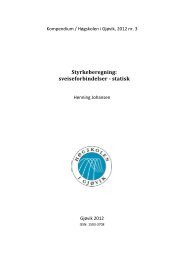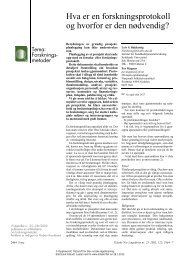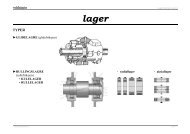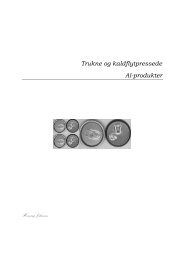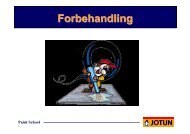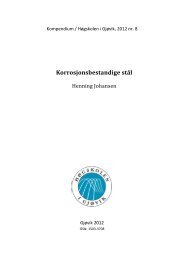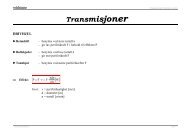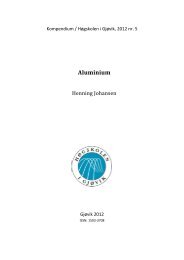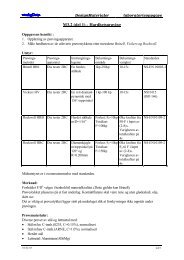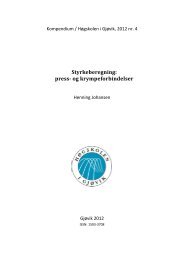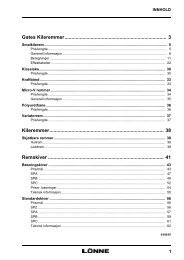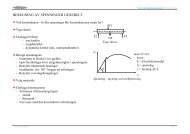Chapter 12 The Periodic Table - Materialteknologi
Chapter 12 The Periodic Table - Materialteknologi
Chapter 12 The Periodic Table - Materialteknologi
Create successful ePaper yourself
Turn your PDF publications into a flip-book with our unique Google optimized e-Paper software.
History• Russian scientist Dmitri Mendeleevtaught chemistry in terms ofproperties.• Mid 1800 - molar masses of elementswere known.• Wrote down the elements in order ofincreasing mass.• Found a pattern of repeating properties.
Mendeleev’s s <strong>Periodic</strong> <strong>Table</strong>Dmitri Mendeleev
Mendeleev’s s <strong>Table</strong>• Grouped elements in columns by similarproperties in order of increasing atomicmass.• Found some inconsistencies - felt thatthe properties were more important thanthe mass, so switched order.• Found some gaps.• Must be undiscovered elements.• Predicted their properties before theywere found.
<strong>The</strong> modern table• Elements are still grouped by properties.• Similar properties are in the samecolumn.• Order is in increasing atomic number.• Added a column of elements Mendeleevdidn’t t know about.• <strong>The</strong> noble gases weren’t t found becausethey didn’t t react with anything.
<strong>The</strong> <strong>Periodic</strong> <strong>Table</strong>Group orfamilyPeriod
• Horizontal rows are called periods• <strong>The</strong>re are 7 periods• Periods represent the electronenergy levels
• Elements are placed in columns bysimilar properties.• Vertical columns are called groups• Also called families
1A2A• <strong>The</strong> elements in the A groupsare called the representativeelements3A 4A 5A 6A7A8A0
<strong>The</strong> group B are called thetransition metalsuu<strong>The</strong>se are called the inner transitionmetals and they belong hereAlso called the rare Earth metals
• Group 1A are the alkali metals• Group 2A are the alkaline earth metals
Alkali Metals• Very reactive• Not found alone in nature because thereact to form compounds• Have one valence electron• Easily lose their valence electron toform a +1 ion
Alkaline Earth Metals• Less reactive then Alkali metals family• Have two valence electrons• Lose their valence electrons to formions with a +2 charge
• Group 7A is called the Halogens• Group 8A are the noble gases
Halogen Family• Very reactive• Have 7 valence electrons• <strong>The</strong>y gain one electron to form a -11 ion
Noble Gases• Do not react• Will not form compounds (except undervery rare circumstances)• <strong>The</strong>y are inert gases because inertmeans non-reactivereactive
Metals and Nonmetals• A zigzag line separates the metals fromthe nonmetals• Lanthanide and Actinide Serieselements (ones at the bottom) areMetals• Metalloids, which straddle the line, areconsidered non-metals
Metals
Properties of Metals Metals are goodconductors of heat andelectricity Metals are malleable Metals are ductile Metals have hightensile strength Metals have luster
Examples of MetalsPotassium, Kreacts withwater andmust bestored inkeroseneCopper, Cu, is a relatively softmetal, and a very good electricalconductor.Zinc, Zn, ismore stablethan potassiumMercury, Hg, is the onlymetal that exists as aliquid at room temperature
• Dull• Brittle• Nonconductors-insulatorsNon-metals
Properties of Nonmetals…Carbon, the graphite in “pencillead” is a great example of anonmetallic element.• Nonmetals are poor conductors ofheat and electricity• Nonmetals tend to be brittle• Many nonmetals are gases at roomtemperature
Examples of NonmetalsSulfur, S, wasonce known as“brimstone”Microspheresof phosphorus,P, a reactivenonmetalGraphite is not the onlypure form of carbon, C.Diamond is also carbon;the color comes fromimpurities caught withinthe crystal structure
Metalloids or Semimetals• Properties of both• Semiconductors
Properties of MetalloidsMetalloids straddlethe border betweenmetals and nonmetalson the periodictable. <strong>The</strong>y have properties of both metals andnonmetals.Metalloids are more brittle than metals, lessbrittle than most nonmetallic solids Metalloids are semiconductors of electricity Some metalloids possess metallic luster
Silicon, Si – A MetalloidOther metalloids include:‣ Boron, B‣ Germanium, Ge‣ Arsenic, As‣ Antimony, Sb‣ Tellurium, Te Silicon has metallic luster Silicon is brittle like a nonmetal Silicon is a semiconductor ofelectricity



